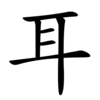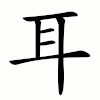耳
See also: 目
| ||||||||
| ||||||||
Translingual
| Stroke order | |||
|---|---|---|---|
| Stroke order (Japan) | |||
|---|---|---|---|
| Stroke order (Chinese) | |||
|---|---|---|---|
 | |||
| Stroke order (Japan) | |||
|---|---|---|---|
 | |||
Alternative forms
When part of a compound character, particularly as the left radical, the bottom horizontal stroke may not cross at bottom right. This is a script variant, found for example in Japanese 聴.
Han character
耳 (Kangxi radical 128, 耳+0, 6 strokes, cangjie input 尸十 (SJ), four-corner 10400)
- Kangxi radical #128, ⽿.
Derived characters
References
- KangXi: page 965, character 5
- Dai Kanwa Jiten: character 28999
- Dae Jaweon: page 1413, character 12
- Hanyu Da Zidian (first edition): volume 4, page 2783, character 1
- Unihan data for U+8033
Chinese
| trad. | 耳 | |
|---|---|---|
| simp. # | 耳 | |
| 2nd round simp. | ⿻二⿰丨丨 | |
Glyph origin
| Historical forms of the character 耳 | ||||||
|---|---|---|---|---|---|---|
| Shang | Western Zhou | Warring States | Shuowen Jiezi (compiled in Han) | Liushutong (compiled in Ming) | ||
| Bronze inscriptions | Oracle bone script | Bronze inscriptions | Chu slip and silk script | Qin slip script | Small seal script | Transcribed ancient scripts |
 |
 |
 |
 |
 |
 |
 |
Characters in the same phonetic series (耳) (Zhengzhang, 2003)
Pictogram (象形) – an ear.
Etymology 1
From Proto-Sino-Tibetan *r/g-na (“ear”).
Pronunciation
Definitions
耳
Synonyms
Dialectal synonyms of 耳朵 (“ear”) [map]
Etymology 2
(This etymology is missing or incomplete. Please add to it, or discuss it at the Etymology scriptorium.)
Pronunciation
Definitions
耳
- (literary) Phrase-final particle: merely; only; that's all
- 二三子,偃之言是也!前言戲之耳。 [Classical Chinese, trad.]
- From: The Analects of Confucius, c. 475 – 221 BCE, translated based on James Legge's version
- Èrsānzǐ, Yǎn zhī yán shìyě! Qiányán xì zhī ěr. [Pinyin]
- My disciples, Yan's words are right. What I said was only in sport.
二三子,偃之言是也!前言戏之耳。 [Classical Chinese, simp.]
Pronunciation
Compounds
Derived terms from 耳
|
|
|
References
- “耳”, in 漢語多功能字庫 (Multi-function Chinese Character Database), 香港中文大學 (the Chinese University of Hong Kong), 2014–
- “Entry #2604”, in 臺灣閩南語常用詞辭典 [Dictionary of Frequently-Used Taiwan Minnan] (in Chinese and Min Nan), Ministry of Education, R.O.C., 2011.
Japanese
Etymology
| Kanji in this term |
|---|
| 耳 |
| みみ Grade: 1 |
| kun’yomi |
- ⟨mi1mi1⟩ → */mimi/ → /mimi/
From Old Japanese. First attested in the Nihon Shoki of 720 CE.[1] From Proto-Japonic *mimi.
Noun
耳 • (mimi)
Derived terms
References
- “耳”, in 日本国語大辞典 (Nihon Kokugo Daijiten, “Nihon Kokugo Daijiten”) (in Japanese), 2nd edition, Tōkyō: Shogakukan, 2000, →ISBN
- 2006, 大辞林 (Daijirin), Third Edition (in Japanese), Tōkyō: Sanseidō, →ISBN
- 1998, NHK日本語発音アクセント辞典 (NHK Japanese Pronunciation Accent Dictionary) (in Japanese), Tōkyō: NHK, →ISBN
Korean
Etymology
From Middle Chinese 耳 (MC ȵɨX).
| Historical Readings | ||
|---|---|---|
| Dongguk Jeongun Reading | ||
| Dongguk Jeongun, 1448 | ᅀᅵᆼ〯 (Yale: zǐ) | |
| Middle Korean | ||
| Text | Eumhun | |
| Gloss (hun) | Reading | |
| Hunmong Jahoe, 1527 | 귀〮 (Yale: kwúy) | ᅀᅵ〯 (Yale: zǐ) |
Pronunciation
- (SK Standard/Seoul) IPA(key): [i(ː)]
- Phonetic hangul: [이(ː)]
- Though still prescribed in Standard Korean, most speakers in both Koreas no longer distinguish vowel length.
Okinawan
Compounds
- 耳ぐい (mimigui, “cloud ear fungus”)
Etymology
From Proto-Ryukyuan *mimi, from Proto-Japonic *mimi. Cognate with mainland Japanese 耳 (mimi).
Vietnamese
This article is issued from Wiktionary. The text is licensed under Creative Commons - Attribution - Sharealike. Additional terms may apply for the media files.